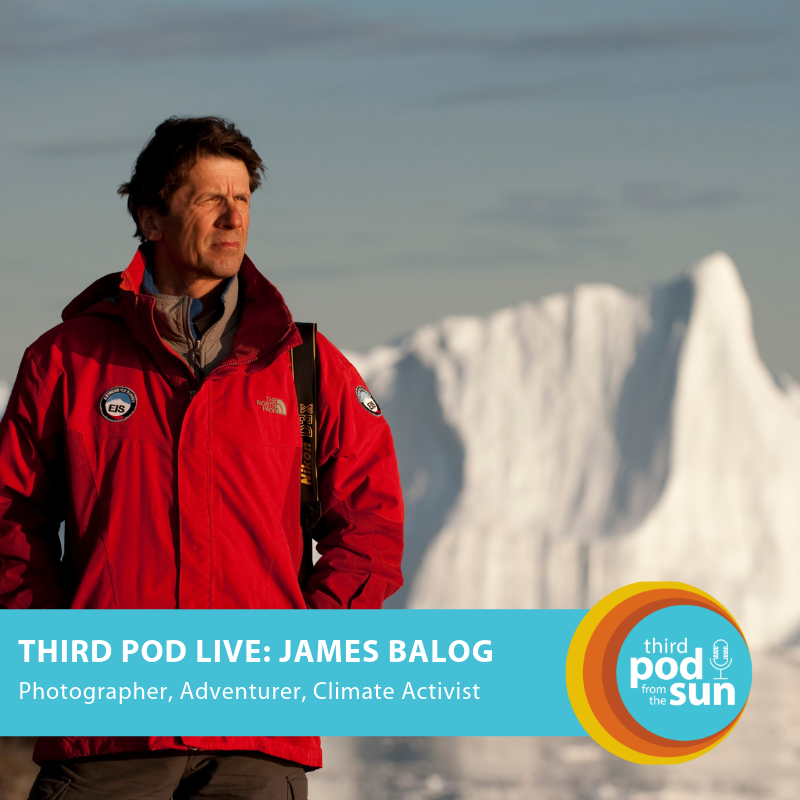11 March 2019
Is Chasing Ice an effective message on climate change?
Posted by Shane Hanlon
By Shane M Hanlon

Our podcast team interviewed Balog at AGU18!
In 2005 and 2006, photographer James Balog set out on expeditions to document the recession of the Sólheimajökull Glacier in Iceland. In many ways, these expeditions changed his life. In 2007, Balog and companions founded the Extreme Ice Survey (EIS), an organization devoted to documenting the effects of climate change on glaciers through time-lapse photography. Over 10 years later, the EIS “…provides scientists with basic and vitally important information on the mechanics of glacial melting and educates the public with firsthand evidence of how rapidly the Earth’s climate is changing.”1
Recently, the authors of Witnessing glaciers melt: climate change and transmedia storytelling set out examine the ways in which the EIS spreads the word about human-caused climate change through transmedia, or the technique of spreading a message or story across multiple platforms. Transmedia communication is currently popular in many sectors including entertainment, marketing, and public relations but is perhaps less-used in science communication and education.2 But it could (and should) be used in scicomm. By messaging across different types of media, using different story subjects, transmedia communication doesn’t assume that “one size fits all.” It also prevents communication via the deficit model, or the idea that folks just don’t understand something because they’re missing the information. This is almost always wrong (with some great examples from this study on public opinions of climate change w/ respect to political party).
The authors set out to ask two major questions:
- How is the vicarious witnessing of climate change structured and made possible by the EIS project?
- How can scientific evidence of climate change be translated through photography and transmedia storytelling, in order to more effectively communicate and engage the general public?
Balog documented the work of the EIS in his film Chasing Ice. Using it as a case study, the authors identified some strong points of the film:
- It forces viewers to bear witness through effective storytelling. There are a bunch of different filming locations, modes of transportation, people identified in the field, etc. Most viewers watching can relate at least something and/or someone in the film.
- It highlights the personal struggles mixed with a scientific endeavor. Chasing Ice is a film about Balog, not climate change. It’s his (and his crew’s) struggle document a cataclysmic event and to ensure that the message is sent. It’s an effective mix of personal and professional.
- It effectively uses transmedia storytelling. The film is, well, a film. But it’s a film documenting a photographic effort. It’s shared through social media. Viewers can geolocate scenes in the film on Google Earth. It’s visually stunning across media.
The main drawback of the study is that they were unable to measure any engagement/action(s) that viewers took after watching the movie. This is a major drawback, to be sure, but there is anecdotal evidence out that shows Chasing Ice is swaying opinion and influencing perception. One of the most notable is this reaction from a woman who saw the film. If you haven’t seen it, take a few minutes to watch it. It’s worth your time.
Our Third Pod from the Sun team had a chance to sit down with Balog at AGU18 and last week released a three-part interview where they talked about everything from how he got his start as a photographer, to some of the most dangerous situations he’s faced, to his current role as a climate activist. Take a listen!
The combination of the manuscript and our chat with Balog got me thinking about some interesting questions that are worth contemplating (and, discussiong):
- What are the pros/cons of having Balog as the centerpiece of Chasing Ice versus just “sticking to the science”?
- Related, do you think Chasing Ice IS a story about Balog or is he just an accessory?
- Is transmedia storytelling the way to go? Should we be focused on spreading science information via as many platforms as possible, at the risk of diluting a message, or focus solely on one?
- What could the film have done better? What would you have included?
Have thoughts you’d like to add? Head over to AGU’s online community AGU Connect, to join the discussion. Not an AGU member? No worry – it’s free to join!
We’re interested in your thoughts. Let’s have a discussion!
-Shane M Hanlon is Program Manager of AGU’s Sharing Science Program. Find him @ecologyofshane.
—
- “About EIS.” Extreme Ice Survey, Earth Vision Institute, 2014, http://extremeicesurvey.org/about-eis/.
- Moloney, K. and Unger, M. 2014. ‘Transmedia storytelling in science communication: one subject, multiple media, unlimited stories’. In: New trends in earth-science outreach and engagement. Ed. by J. L. Drake, Y. Y. Kontar and G. S. Rife. Berlin, Germany: Springer International Publishing, pp. 109–120.










 The Plainspoken Scientist is the science communication blog of AGU’s Sharing Science program. With this blog, we wish to showcase creative and effective science communication via multiple mediums and modes.
The Plainspoken Scientist is the science communication blog of AGU’s Sharing Science program. With this blog, we wish to showcase creative and effective science communication via multiple mediums and modes.